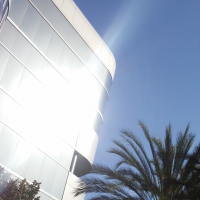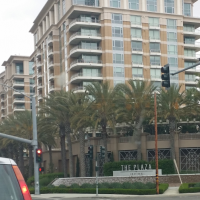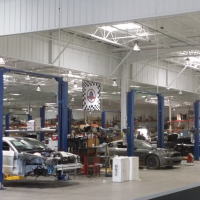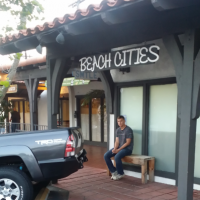WELCOME:
We do: COMMON COMMERCIAL REAL ESTATE & LENDING SECURES FINANCING FOR INVESTORS AND SMALL BUSINESS OWNERS.
We Secure Financing Via SBA Loans, Commercial Real Estate Loans and C&I Loans. PREFERRED PROPERTY TYPES ARE OFFICE, INDUSTRIAL, RETAIL, MULTIFAMILY, MEDICAL AND SPECIAL PURPOSE
PURCHASE AND REFINANCING OPTIONS:
UP TO 10 YEARS FIXED RATE AND 30 YEAR AMORTIZATION
Introduction
Hello and thank you for your interest in our commercial real estate and small business lending products. Our loan officers have extensive experience in business development, finance, credit administration, policy writing, underwriting, special assets-commercial loan workouts, risk management and research & development. Our primary goal is to make sure that clients are 100% satisfied with the products and services that are delivered. We want our clients to have access to the most competitive rates and terms so that it achieves their financial goals.
The ideal client is a real estate investor or business owner who is in need of financing for the following reasons: purchase or refinance commercial real estate, equipment & machinery acquisition, working capital, business acquisition and debt refinance.
When it’s time to make important real estate or financial decisions for your company we know that it can be stressful, complicated, expensive and overwhelming. Our mission is to make the financing process relatively painless, simple, cost effective and even enjoyable.
Common Commercial Real Estate (CCRE) originates commercial real estate and small business loans for investors and small business owners throughout California as well as nationwide. We provide investors and small business owners access to the most competitive financing through prominent national & regional banks, credit unions and private lenders.
For commercial real estate loans we can secure financing for purchases and refinances of existing loans up to $15,000,000. We will provide competitive loan products for a full range of properties, including apartments, retail/shopping centers, office, industrial, single-tenant net lease, medical and special purpose. Fixed interest rates are offered at the periods of 3 years, 5 years, 7 years and 10 years. Depending on the property type, loans can be amortized for up to 30 years. Some of the lenders that we work with offer no origination fees and no pre-payment penalties.
For small business owners, CCRE can secure revolving lines of credit (secured & unsecured) from $50,000 up to $2,000,000; equipment term loans up to $1,500,000; fixed rate commercial real estate loans up to $15,000,000; and SBA loans up to $5,000,000.
Is a commercial loan right for you?
Commercial Loan Uses
-
Commercial Real Estate Purchase
- Commercial Real Estate Refinance
- 1031 Exchange
-
Business Acquisition
-
Business Expansion
-
Purchase Equipment
-
Lines of Credit
-
Long-Term Working Capital
- Debt Refinance
WE MAKE LOANS ON PROPERTIES INCLUDING:
- Retail
- Apartments
- Factories / Industrial
- Shopping Centers
- Office Buildings
- Warehouses
- Industrial
- Mixed-Use / Single Use
- Owner Occupied
- Medical
REAL ESTATE PROPERY
The term commercial property (also called commercial real estate, investment or income property) refers to buildings or land intended to generate a profit, either from capital gain or rental income.
Commercial real estate is commonly divided into six categories:
1. Office Buildings – This category includes single%u2010tenant properties, small professional office buildings, downtown skyscrapers, and everything in between.
2. Industrial – This category ranges from smaller properties, often called "Flex" or "R&D" properties, to larger office service or office warehouse properties to the very large "big box" industrial properties. An important, defining characteristic of industrial space is Clear Height. Clear height is the actual height, to the bottom of the steel girders in the interior of the building. This might be 14%u201016 feet for smaller properties, and 40 feet for larger properties. We also consider the type and number of docks that the property has. These can be Grade Level, where the parking lot and the warehouse floor are on the same level, to semi%u2010dock height at 24 inches, which is the height of a pickup truck or delivery truck, or a full%u2010dock at 48 inches which is semi%u2010truck height. Some buildings may even have a Rail Spur for train cars to load and unload.
3. Retail/Restaurant – This category includes pad sites on highway frontages, single tenant retail buildings, small neighborhood shopping centers, larger centers with grocery store anchor tenants, "power centers" with large anchor stores such as Best Buy, PetSmart, OfficeMax, and so on even regional and outlet malls.
4. Multifamily – This category includes apartment complexes or high%u2010rise apartment buildings. Generally, anything larger than a fourplex is considered commercial real estate.
5. Land – This category includes investment properties on undeveloped, raw, rural land in the path of future development. Or, infill land with an urban area, pad sites, and more.
6. Special Purpose – This category would include any other nonresidential properties such as hotel, hospitality, medical and self storage. Other property types could be considered in this category.
MORTGAGE & LENDING
A commercial mortgage is a mortgage loan secured by commercial property, such as an office building, shopping center, industrial warehouse, or apartment complex. The proceeds from a commercial mortgage are typically used to acquire, refinance, or redevelop commercial property.
Commercial mortgages are structured to meet the needs of the borrower and the lender. Key terms include the loan amount (sometimes referred to as "loan proceeds"), interest rate, term (sometimes referred to as the "maturity"), amortization schedule, and prepayment flexibility. Commercial mortgages are generally subject to extensive underwriting and due diligence prior to closing. The lender's underwriting process may include a financial review of the property and the property owner (or "sponsor"), as well as commissioning and review of various third-party reports, such as an appraisal.
There were $3.1 trillion of commercial and multifamily mortgages outstanding in the U.S. as of June 30, 2013. Of these mortgages, approximately 49% were held by banks, 18% were held by asset-backed trusts (issuers of CMBS), 12% were held by government-sponsored enterprises and Agency and GSE-backed mortgage pools, and 10% were held by life insurance companies.
Recourse
Commercial mortgages may be recourse or non-recourse. A recourse mortgage is supplemented by a general obligation of the borrower or a personal guarantee from the owner(s) of the property, which makes the debt payable in full even if foreclosure on the property does not satisfy the outstanding balance. A nonrecourse mortgage is secured only by the commercial property that serves as collateral. In an event of default, the creditor can foreclose on the property, but has no further claim against the borrower for any remaining deficiency.
If a sponsor is seeking financing on a portfolio of commercial real estate properties, rather than a single property, the sponsor may choose to take out a cross-collateralized loan, in which the all of the properties collateralize the loan.
LENDERS
Underwriting metrics
Lenders usually require a minimum debt service coverage ratio which typically ranges from 1.10 to 1.50; the ratio is net cash flow (the income the property produces) over the debt service (mortgage payment).
Lenders also look at loan to value (LTV). LTV is a mathematical calculation which expresses the amount of a mortgage as a percentage of the total appraised value. For instance, if a borrower wants $6,000,000 to purchase an office worth $10,000,000, the LTV ratio is $6,000,000/$10,000,000 or 60%. Commercial mortgage LTV's are typically between 55% and 75%, unlike residential mortgages which are typically 80% or above. SBA loans provide LTV's of 90%max.
Lenders look at rents per square foot, cost per square foot and replacement cost per square foot. These metrics vary widely depending on the location and intended use of the property, but can be useful indications of the financial health of the real estate, as well as the likelihood of competitive new developments coming online.
Since the financial crisis, lenders have started to focus on a new metric, debt yield, to complement the debt service coverage ratio. Debt yield is defined as the net operating income (NOI) of a property divided by the amount of the mortgage.
Underwriting practices
Lenders typically do thorough extreme due diligence on a proposed commercial mortgage loan prior to funding the loan. Such due diligence often includes a site tour, a financial review, and due diligence on the property's sponsor and legal borrowing entity. Many lenders also commission and review third-party reports such as an appraisal, environmental report, engineering report, and background checks.
ABOUT CALIFORNIA
California is the most populous state in the United States and the third-most extensive state by area. Los Angeles, in Southern California, is the state's largest city and the country's second largest city after New York City. California also includes the nation's most populous county, Los Angeles County, and the largest county by area, San Bernardino County. Geographically located in the western part of the United States, California is bordered by the other U.S. states of Oregon to the north, Nevada to the east, and Arizona to the southeast. California shares an international border with the Mexican state of Baja California to the south and the Pacific Ocean is on the state's western coastline. The state capital is Sacramento located in Northern California.
What is now California was first settled by various Native American tribes before being explored by a number of European expeditions during the 16th and 17th centuries. It was then claimed by the Spanish Empire as part of Alta California in the larger territory of New Spain. Alta California became a part of Mexico in 1821 following its successful war for independence, but was ceded to the United States in 1848 after the Mexican–American War. The western portion of Alta California was organized as the State of California, which was admitted as the 31st state on September 9, 1850. The California Gold Rush starting in 1848 led to dramatic social and demographic changes, with large-scale immigration from the east and abroad with an accompanying economic boom.
California's diverse geography ranges from the Sierra Nevada in the east to the Pacific Coast in the west, from the redwood–Douglas fir forests of the northwest, to the Mojave Desert areas in the southeast. The center of the state is dominated by the Central Valley, a major agricultural area. California contains both the highest point (Mount Whitney) and the lowest point (Death Valley) in the contiguous United States. Earthquakes are common because of the state's location along the Pacific Ring of Fire. About 37,000 earthquakes are recorded each year, but most are too small to be felt. Drought has also become a notable feature.
California has had an enormous influence on global popular culture due to being the birthplace of the film industry, the hippie counterculture, the Internet, and the personal computer. The state's economy is centered on finance, government, real estate services, technology, and professional, scientific and technical business services; together comprising 58% of the state's economy. Three of the world's largest 20 firms by revenue, Chevron, Apple, and McKesson, are headquartered in the state. Although only 1.5% of the state's economy, California's agriculture industry has the highest output of any U.S. state. If it were a country, California would be the 7th largest economy in the worldand the 35th most populous.
MAJOR CITIES IN CALIFORNIA:
Los Angeles is one of the world's centers of media, business, and international trade. It is the second most-populous city in the United States. It is also the home to renowned institutions covering a broad range of educational and professional fields, and it is one of the most substantial economic engines of the United States. Los Angeles (and its Hollywood district) lead the world in producing entertainment such as motion pictures, television, and recorded music.
San Diego sits in the extreme south of California on the border with Mexico. The city has miles of beaches and a number of U.S. military facilities as well as the world's busiest land border crossing. It is known as "the birthplace of California" since it was the first European landfall and the first European settlement in present-day California. Although it is a large city, San Diego doesn't encompass headquarters of very many large corporations. Instead the city's economy largely relies on US defense and military-related industries, tourism, and some international trade. It is home to a number of institutions of higher learning, including the University of California, San Diego, the University of San Diego, San Diego State University, NewSchool of Architecture Design, and Point Loma Nazarene University.
San Jose was founded on November 29, 1777, as one of the first towns in the Spanish colony of Nueva California, which later became Alta California.[2] The town of San Jose served 1849-1851 as the first state capital, when California gained statehood in 1850.[3] After more than 150 years as an agricultural center, San Jose grew due to demand for housing from soldiers returning from World War II, as well as the city's aggressive expansion policy during the 1950s and 1960s as it annexed large portions of land area which helped increase its population. By the 1990s, San Jose's location within the then-booming local technology industry earned the city the nickname Capital of Silicon Valley, and it hosts several prominent technology companies including Adobe Systems and Cisco Systems. San Jose is home to the National Hockey League's San Jose Sharks in addition to Major League Soccer's San Jose Earthquakes, as well as San Jose State University.
San Francisco is a popular international tourist destination renowned for its beauty, cosmopolitan flair, steep rolling hills, and eclectic mix of Victorian and modern architecture. The city is surrounded by water on three sides and has many famous landmarks, such as the Golden Gate Bridge, Alcatraz Island, Palace of Fine Arts, the cable cars and streetcars, Coit Tower, and Chinatown. The city is well known for its left-wing politics and its diverse population, including large and long-established Asian American and LGBT communities. It is the most densely populated major city in California and is the second most densely populated major city in the United States, only after New York City. It is also the only consolidated city-county in the state of California. San Francisco is also home to the largest social media, technology, and Bio Tech industries in the world. The City is also ranked the most expensive city in the United States and stands third in the world.
Fresno is at the heart of the San Joaquin Valley, a leading agricultural area of the United States and the world. Fresno is the closest major city to Yosemite National Park and Sequoia National Park. Fresno is the largest inland city in California. It is the home of California State University, Fresno. Fresno is also noted for its large Hmong and Armenian-American communitie
Sacramento has been the state capital of California since 1854. Once the state's second largest city, Sacramento was a major distribution center during the California Gold Rush and was the western terminus of the Pony Express. The American River, where gold was first discovered in California in the middle of the 19th century, flows through the city. In the market boom between 2003 and 2008, the population of the metropolitan area reached close to 2.5 million people as suburbs such as Roseville, Lincoln, and Elk Grove grew, making the Sacramento region the largest region in the California's Central Valley. According to the 2010 census, Sacramento is the nineteenth most-populous metropolitan area in the United States. Sacramento is home to the National Basketball Association's Sacramento Kings. California State University, Sacramento is situated in the city.
Long Beach is a coastal city in the Greater Los Angeles area metropolitan area. Long Beach partially borders the city of Los Angeles to its west and is home to the Grand Prix of Long Beach and the RMS Queen Mary, which is docked in Long Beach Harbor. The Port of Long Beach is one of the world's largest shipping ports. The city also has a large oil industry; oil is found both underground and offshore. Manufacturers include aircraft, automobile parts, electronic and audiovisual equipment. It is also home to the headquarters for corporations such as Epson America, Molina Healthcare, and Scan Health Care. Long Beach has grown with the development of high-technology and aerospace industries in the area. The California State University system headquarters are in Long Beach, as is the second largest campus of the 23-school system, California State University, Long Beach.
Oakland is a major West Coast port and is home to several major corporations, including Kaiser Permanente and Clorox, as well as being the corporate headquarters for nationwide businesses like Dreyer's and Cost Plus World Markets. Attractions include Jack London Square, the Oakland Museum of California, the Chabot Space and Science Center, Lake Merritt, the East Bay Regional Park District ridge line parks and preserves, and Chinatown. Oakland is also the home city of three of the Bay Area's major league sports teams—Major League Baseball's Oakland A's, the Oakland Raiders of the National Football League, and the National Basketball Association's Golden State Warriors, with the first two teams playing their home games as O.co Coliseum, while the Warriors play their home games at Oracle Arena.
Anaheim is the most populous city in Orange County and second largest in terms of land area; it is known for its theme parks (including Disneyland), sports teams, and convention center..
Irvine is a planned city, mainly developed by the Irvine Company since the 1960s. Irvine is home to the University of California, Irvine (UCI) and to a number of corporations, particularly in the technology sector. It is regarded for its good schools, jobs and housing by CNNMoney.com, for low crime by the Federal Bureau of Investigation, and the Census Bureau ranks Irvine highly in median income.
Riverside is the most populous city of Southern California's Inland Empire region. Riverside is the birthplace of California's citrus industry and home to the University of California, Riverside (UCR). Its downtown is home to the Mission Inn, one of two historic landmark hotels in California. The Mission Inn Festival of Lights is said to be the third largest Christmas lights display in the nation.
San Bernardino is the second largest city in the Inland Empire metropolitan area of California, and the county seat of San Bernardino County, the largest county in geographic area in the 48 contiguous states. San Bernardino is home to California State University, San Bernardino (CSUSB) and a number of corporations in addition to the San Bernardino International Airport. San Bernardino is the gateway to the San Bernardino Mountains, including its ski resorts and numerous lakes.















